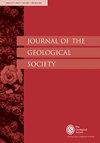40 Ar/ 39 Ar eruption ages of Turkana Basin tuffs: millennial scale resolution constrains paleoclimate proxy tuning models and hominin fossil ages
IF 3
3区 地球科学
Q2 GEOSCIENCES, MULTIDISCIPLINARY
引用次数: 2
Abstract
The Turkana Basin in Kenya/Ethiopia hosts remarkable fossil-rich sediments that are central to our understanding of early hominin evolution, with interbedded volcanic tuffs providing critical time markers. However, the resolution of existing Early Pleistocene/Pliocene ages is limited to ∼20-60 kyr, inhibiting evaluation of climatic/environmental drivers of evolution. Here, we present high precision, single-feldspar 40 Ar/ 39 Ar age and elemental data for four stratigraphically significant tuffs. These samples exhibit variably dispersed age distributions correlated with feldspar compositional trends, interpreted to indicate partial retention of inherited argon, related to crustal ‘cold storage’ and rapid melt infiltration preceding eruption. We evaluated various statistical methods and calculate astronomically calibrated, Bayesian age estimates of 1879.1 ± 0.6 ka (± 2.4 ka including external errors) for the KBS/H2 Tuff, 1837.4 ± 0.9 ka (± 2.4 ka) for the Malbe/H4 Tuff, 1357.5 ± 1.8 ka (± 2.5 ka) for the Chari/L Tuff and 1315.4 ± 1.9 ka (± 2.5 ka) for the Gele Tuff. Our results permit refined age constraints for important early Homo fossils, including the cranium KNM-ER1813 ( Homo habilis ) and various Homo erectus fossils. The KBS Tuff age also provides an important calibration locus for orbital tuning of paleoclimate proxy records, revealing complex interplay between paleoclimate and geological drivers of sedimentation. Supplementary material: https://doi.org/10.6084/m9.figshare.c.6602994图尔卡纳盆地凝灰岩40Ar/39Ar喷发年龄:千年尺度分辨率约束古气候代理调整模型和人类化石年龄
肯尼亚/埃塞俄比亚的图尔卡纳盆地拥有丰富的化石沉积物,这些沉积物对我们了解早期人类进化至关重要,互层的火山凝灰岩提供了关键的时间标志。然而,现有的早更新世/上新世年龄的分辨率仅限于~ 20-60 kyr,这抑制了对进化的气候/环境驱动因素的评估。本文给出了4个具有重要地层意义的凝灰岩的高精度单长石40 Ar/ 39 Ar年龄和元素数据。这些样品显示出与长石成分趋势相关的可变分散的年龄分布,解释为继承氩的部分保留,与地壳“冷储存”和火山爆发前的快速熔体渗透有关。我们评估了各种统计方法,并计算了经天文校正的贝叶斯年龄估计,KBS/H2凝灰岩的年龄估计为1879.1±0.6 ka(±2.4 ka,包括外部误差),Malbe/H4凝灰岩的年龄估计为1837.4±0.9 ka(±2.4 ka), Chari/L凝灰岩的年龄估计为1357.5±1.8 ka(±2.5 ka), Gele凝灰岩的年龄估计为1315.4±1.9 ka(±2.5 ka)。我们的研究结果允许对重要的早期人类化石进行精确的年龄限制,包括头盖骨KNM-ER1813(能人)和各种直立人化石。KBS凝灰岩年龄也为古气候代用记录的轨道校正提供了重要的标定点,揭示了古气候与沉积地质驱动因素之间复杂的相互作用。补充资料:https://doi.org/10.6084/m9.figshare.c.6602994
本文章由计算机程序翻译,如有差异,请以英文原文为准。
求助全文
约1分钟内获得全文
求助全文
来源期刊

Journal of the Geological Society
地学-地球科学综合
CiteScore
6.00
自引率
3.70%
发文量
68
审稿时长
6-12 weeks
期刊介绍:
Journal of the Geological Society (JGS) is owned and published by the Geological Society of London.
JGS publishes topical, high-quality recent research across the full range of Earth Sciences. Papers are interdisciplinary in nature and emphasize the development of an understanding of fundamental geological processes. Broad interest articles that refer to regional studies, but which extend beyond their geographical context are also welcomed.
Each year JGS presents the ‘JGS Early Career Award'' for papers published in the journal, which rewards the writing of well-written, exciting papers from early career geologists.
The journal publishes research and invited review articles, discussion papers and thematic sets.
 求助内容:
求助内容: 应助结果提醒方式:
应助结果提醒方式:


